COMMON LOON IS BEAUTIFUL, VOCAL...DEADLY Bird shares its dark side
By Dick Ellis
The hen mallard cut the middle of the 50-acre Sawyer County lake, leading her new brood of three tiny ducklings on a meandering and endless search for food. The loon cried again, and disappeared.
New life. A loon’s song on gentle winds. Warm sunshine, white clouds, blue skies. Heaven hung over northwest Wisconsin.
“You know there’s fish over there, if the loon is there,” Frank Pratt said as his fly line looped forward to place its feathered cargo gently on the water near the logs and vegetation that had given up six eight-inch bluegills in five minutes. A twitch or two later, another big gill inhaled the fly and was invited in for a quick “hello” and release. Paradise hung on an eight-foot flyrod.
An explosion of water stopped the small talk and demanded our attention. At 80 yards, the loon stood up over the mallard, wings beating and head thrashing. No Disney-hello here. Reality, and a beautiful killer, loomed over a mallard.
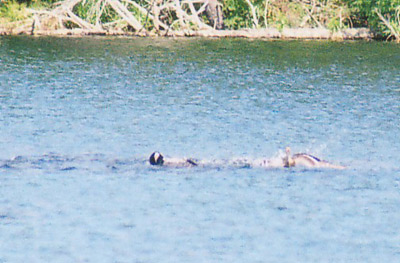 |
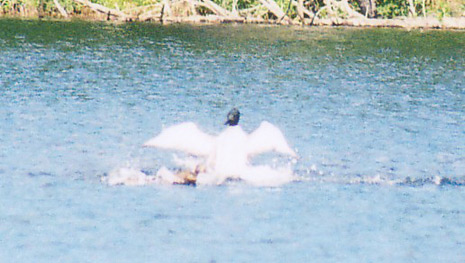 |
| A hen mallard swims in to fend off an attacking loon that has apparently taken one of her newborn ducklings beneath the water. | Moving directly in harms way defending her brood of three ducklings, Mother Hen is met by the loon, which stands up and uses its wings and beak as flailing weapons. |
Mother Nature does what she must, takes what she wants. Mother hen was doing what she could to ensure that her own contribution survived. Over a 30-second battle, the duck fended off the much larger attacker directly before leading him away in a burst of speed for both birds.
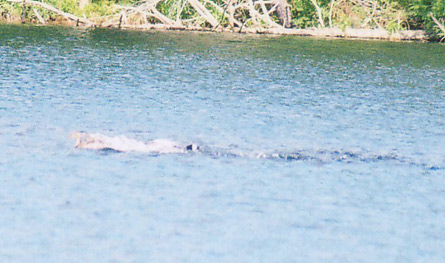 |
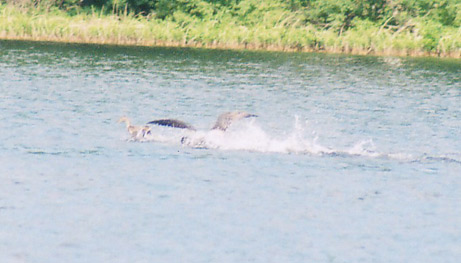 |
| The loon turns its attack back to the duckling as the mallard continues her attempts to intervene. | The loon aggressively sets out after the mallard hen. |
As quickly as it began, it ended. The loon rested and the mallard moved away. Uncertain of what we had seen we pulled the anchor and moved toward the answers...
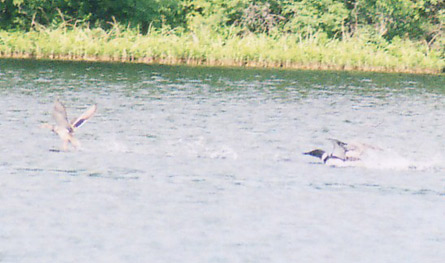 |
| The chase continues until the loon stops the attack after 30 seconds. |
According to Cory MacNulty, Ecologist and Environmental Educator at the Sigurd Olson Environmental Institute of Northland College in Ashland, and Coordinator of LoonWatch at the Institute, loons are extremely territorial. Protecting home territory, she said, occasionally leads to attacks on ducks or other wildlife, and even to fatal attacks on other loons.
“Loons will aggressively defend their territory, mostly from other loons,” MacNulty said. “They jab each others beaks, beat each other with their wings and pull each other under water. There are documented cases of loons killing other loons by spearing the sternum. Their goal in life is to reproduce. They need territory to do it.”
“Intruder loons”, she said, will also initiate combat in another bird’s territory in an attempt to take over that area, and if successful, kill the rival’s chicks. In documented incidents from eastern states, intruder loons might also kill the chicks first, prior to engaging the adults. Theoretically, she said, that may reduce long-term competition.
According to MacNulty, loons spend the spring and early summer breeding season in the northern United States, including the northern one-third of Wisconsin. Based on a LoonWatch state population surveys of adult birds coordinated every five years, approximately 3,100 loons summered in Wisconsin in 2000.
In late fall, usually beginning in October, adult loons group up and migrate before the chicks from Wisconsin, Michigan and Minnesota to territory ranging from the Gulf of Florida to the coast of Carolina according to banding studies and satellite surveys. Depending on individual development, the chicks follow sometime prior to ice-up, although it is uncertain how they find their way without adult guidance.
“Nobody knows how they do it,” MacNulty said. “It’s kind of a miracle. But it’s a miracle that any loons survive, given the threats.”
LoonWatch volunteers, she said, monitor Wisconsin loons and those threats and have been more frequently reporting interactions between eagles and loons. One adult loon was recently attacked and killed on its nest by an eagle, which also will often take loon eggs or chicks. There is no research to date of the impact, if any, of the increasing eagle population on loon numbers.
Loon eggs, usually one or two but as many as three per nesting pair also suffer predation losses from raccoons, skunks, otters, weasels and fox and avian threats from eagles, ravens, and gulls. If the hatch is successful, loon chicks face ongoing threats from snapping turtles, musky and northern pike. Nesting mortality, particularly the eggs of mainland nesters is higher than post-hatch mortality.
Like every species in the wild, the world of the loon is a life of kill and be killed. A life of not-so-simple survival.
…As we approached, a dead duckling no more than a few days old lay floating on the water. As it rested on my hand for the final pictures recording the encounter, and a rare reporter’s opportunity, there was a brief tug of remorse at a human heart ( a bit strange, I thought, since I would have tried to shoot these ducks this October) To a heartless Mother Nature, this was business as usual.
From the far end of the Sawyer County puddle, the loon cried. In the reeds near the landing, the hen mallard gently paddled with two ducklings in an endless journey in search of food. Warm sunshine, peace and quiet told us there was still time to fish.
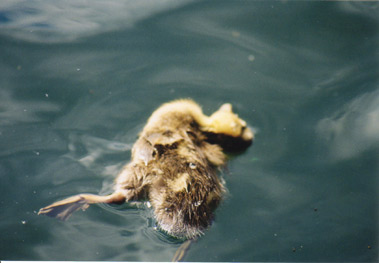 |
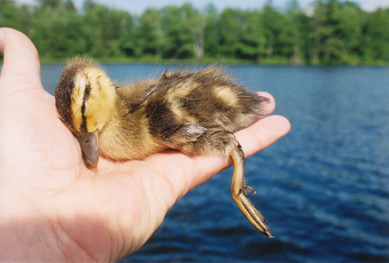 |
| The attack site is approached, and the newborn duckling is found dead floating on the water. Two ducklings survive. | The dead duckling rests on a reporter’s hand in the final photo recording the attack. |
“Let’s go try the other end of the lake,” Frank Pratt said, eyeing up his flyrod arsenal. “There’s a lot of bass there.”
Heaven hung over northwest Wisconsin.
LOON WATCH
LoonWatch, said Program Coordinator Cory MacNulty, is celebrating its 25th anniversary working to protect common loons in their aquatic habitat through education, monitoring, and research. The education component, she said, including a speaker’s bureau that sends volunteer loon experts to address schools, public groups and other organizations, is vital to protecting this beautiful bird with the haunting calls.
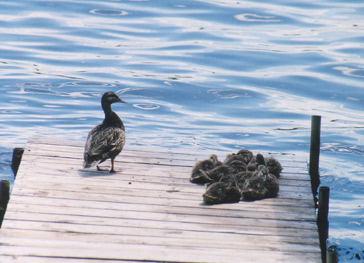 |
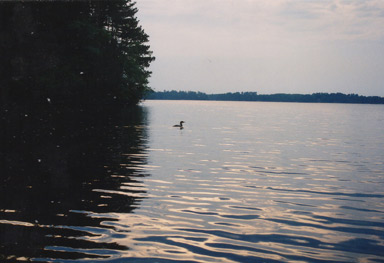 |
| Ever diligent for predators or other danger, a mallard hen stands guard this week as her growing brood rests on a northern Wisconsin pier. | According to LoonWatch of Ashland, loons are extremely territorial and will aggressively defend home turf or attempt a hostile takeover of desired territory. In such an attempt, baby loons are sometimes intentionally killed, and adults sometimes lose their lives in combat. |
“People do not intentionally harm the loon and will change their own behaviors when they learn it will help loons,” she said. “Human threats to loons include shoreline development and direct elimination of loon nesting habitat. It’s pretty specific nesting habitat. Threats also include direct human disturbances from recreational boats that hit chicks or wash eggs out of the nest.”
Stressing that it is not just power boats that endanger loons, but people in virtually any craft venturing too close to nests to photograph or observe eggs, chicks and adults. The very behavior of a nervous loon will clearly tell people if they are too close she said, recommending instead that visitors use binoculars to observe the birds’ most natural demeanor.
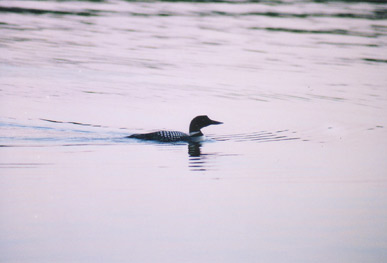 |
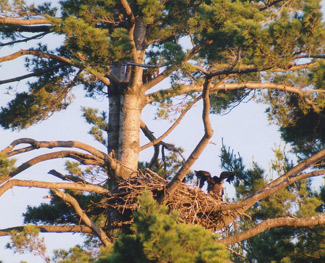 |
| According to LoonWatch of Ashland, loons are extremely territorial and will aggressively defend home turf or attempt a hostile takeover of desired territory. In such an attempt, baby loons are sometimes intentionally killed, and adults sometimes lose their lives in combat. | A baby eagle tests its wings on the edge of its nest. The need for eaglet nourishment leads eagle parents to sometimes attack loon nests for eggs or young loon chicks. LoonWatch reports the recent killing of an adult loon on its nest by an eagle. |
Mercury contamination is another threat to loons, MacNulty said. “Loons are at the top of the food chain; they eat fish,” she said. “They pick up a lead sinker or a jig and they grind it up in their gizzard and become poisoned, or take a fish with lead in it. Humans receive health advisories and can alter their eating habits. Loons can’t.”
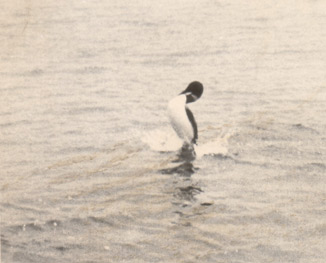 |
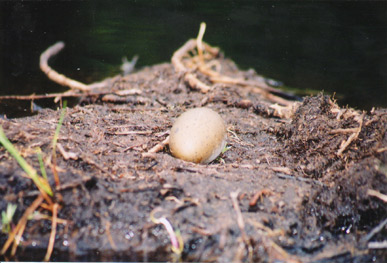 |
| An adult loon cries and stands on the water in a threatening dance to an eagle threatening its nest. | A loon nest with eggs will face multiple threats from man and predator, according to LoonWatch. If successfully hatched, northern pike, muskies, eagles, and snapping turtles make the road of survival a less than certain journey for loon chicks. |
LoonWatch coordinates an annual loon monitoring program with approximately 200 volunteer “Loon Rangers” who keep track of the birds on their home lakes throughout Wisconsin. Anyone, MacNulty said, can become a Loon Ranger or learn to give presentations as part of the LoonWatch Speakers’ Bureau. For more information, on these or other programs, or additional information on the common loon, contact LoonWatch at:
LoonWatch
Sigurd Olson Environmental Institute
Northland College
Ashland, WI 54806
715-682-1220
loonwatch@northland.edu
www.northland.edu/soei/loonwatch.html
LOON FACTS
Although all loons will be vocal and are territorial, only the male loon can produce the distinctive territorial yodel call. According to LoonWatch Coordinator Cory MacNulty, that call is the only way to distinguish males from females in the wild.
Among mated pairs of loons, the male is virtually always larger. Individually, a large female can be larger than a small male. The birds’ average weight is between six and 12 pounds.
While most birds’ bones are predominantly hollow, the loons’ bones are solid. This physical characteristic make a long water runway necessary for the loon to become airborne and continual wing flapping once the bird is flying.
The loon’s “wing loading ratio”, figured by comparing the weight of the bird to the surface area of the wings, is the largest in the bird family. For example, although approximately the same weight, the eagle can soar without flapping its wings in flight due to the bird’s significantly greater wing size.






